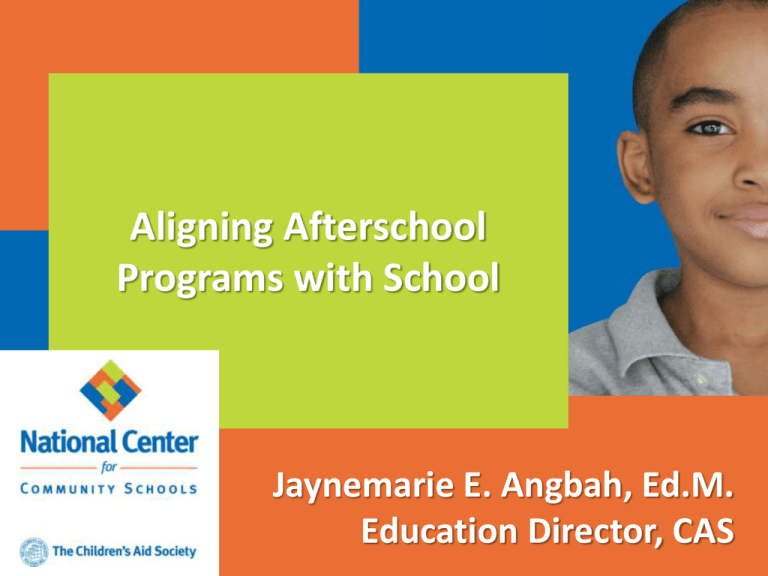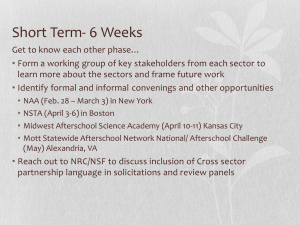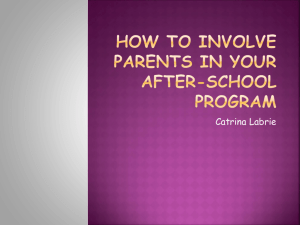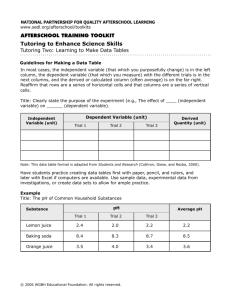Aligning Afterschool Programs with Academic Standards
advertisement

Aligning Afterschool Programs with School Jaynemarie E. Angbah, Ed.M. Education Director, CAS Workshop Objectives Understand expanded learning time and its connection to common core aligned programming. Define and review Common Core State Standards (CCSS.) Understand how afterschool program activities can support the achievement of CCSS. Identify the structures and supports necessary for staff to incorporate and implement standardsbased programming. Pair and Share Activity Think about an afterschool activity from your program in which young people were/are engaged in a meaningful learning experience. Working in partners, briefly describe the activity and what students learned. Report back Afterschool Programs and Student Learning NCLB and a national focus on closing the achievement gap have led to increased expectations for afterschool programs to provide academic support and enrichment. Afterschool programs have always cared about supporting youth cognitive development as part of positive youth development (Dev. Domains.) Now, however, we must become more intentional about the link between afterschool and student learning and clearly articulate this link to key stakeholders (parents, funders, school partners.) Why do we need ELT? “Could someone help me with these? I’m late for math class.” Scott Spencer Definition of Expanded Learning Time Expanded Learning Time (ELT) programs add time to the school day, week or year ELT programs are an example of Expanded Learning Opportunities (ELO), a framework which includes before-school, afterschool and summer learning programs “…expanded learning time programs should go beyond simply adding additional time to the school day and incorporate successful afterschool practices: engaging students in their own education by providing hands-on, experiential learning opportunities through community partnerships that build on—but do not replicate—learning that happens during the school day. ” -The Afterschool Alliance Key Principles of ELOs School/Community Partnerships Engaged Learning Family Engagement Intentional Programming Diverse, Prepared Staff Participation & Access Safety, Health & Wellness Ongoing Assessment & Improvement *Afterschool Alliance, Principles of Effective Expanded Learning Programs, January 2012 ELT Strategies for 21st CCLCs Education Coordinators to help with school/afterschool alignment and integration Targeted programming Blended staffing patterns (classroom teachers and youth developers) Joint planning and professional development (school and afterschool staff) Partners develop shared goals and systems for sharing of relevant child/youth data Common Core State Standards Historically, state departments of education developed their own academic standards. In 2009, governors and state commissioners of education from 48 states, 2 territories and the District of Columbia (D.C.) committed to developing the Common Core State Standards (CCSS) for proficiency in English-language arts and Mathematics for grades K-12 . The CCSS define the knowledge and skills students should have within their K-12 education, so that they will graduate from high school college and career ready. To date, 45 states and D.C. have adopted the CCSS. New state tests aligned with the CCSS will be rolled out in the 2014-2015 school year. Common Core State Standards in New York State In January 2011, the Board of Regents approved the New York State P-12 Common Core Learning Standards (CCLS), which are the compilation of the Common Core State Standards (CCSS) and the additional standards developed by the NY State Department of Education (NYSED.) In order to prepare students and teachers over the next three years for the Common Corealigned state assessments of 2014-2015, The New York State Education Department (NYSED) is starting to align their summative assessments to the CCLS in 2012-2013. What does it mean to be college and career ready? Students who meet the ELA standards will be able to: • Demonstrate independence. • Build strong content knowledge. • Respond to the varying demands of audience, task, purpose, and discipline. • Comprehend, as well as critique information. • Value evidence. • Use technology and digital media strategically and capably. • Come to understand other perspectives and cultures. Students who meet the Math standards will be able to: • Make sense of problems and persevere in solving them. • Reason abstractly and quantitatively. • Construct viable arguments and critique the reasoning of others. • Model with mathematics. • Use appropriate tools strategically. • Attend to precision. • Look for and make use of structure. • Look for and express regularity in repeated reasoning. Implementing Common Core Standards Sandra Alberti Student Achievement Partners September 26, 2011 ELA/Literacy: 6 shifts* 1. Gr. K-5: Balance of fiction and informational texts. 2. Gr. 6-12: More non-fiction in English class and incorporating reading/writing into other subject areas (e.g. science) 3. Reading grade-level appropriate texts 4. Asking questions the answers to which can only be found in a deep reading of the text 5. Writing to inform or argue using evidence 6. Academic Vocabulary *Adapted from Sandra Alberti, Student Achievement Partners, 2011 Mathematics • • • • • • • • FOCUS FOCUS FOCUS Coherence Fluency Deep Understanding Application Intensity Priorities in Mathematics Grade K–2 3–5 6 7 8 Priorities in Support of Rich Instruction and Expectations of Fluency and Conceptual Understanding Addition and subtraction, measurement using whole number quantities Multiplication and division of whole numbers and fractions Ratios and proportional reasoning; early expressions and equations Ratios and proportional reasoning; arithmetic of rational numbers Linear algebra Key Fluencies Grade Required Fluency K Add/subtract within 5 1 Add/subtract within 10 2 3 4 5 6 Add/subtract within 20 Add/subtract within 100 (pencil and paper) Multiply/divide within 100 Add/subtract within 1000 Add/subtract within 1,000,000 Multi-digit multiplication Multi-digit division 7 Multi-digit decimal operations Solve px + q = r, p(x + q) = r 8 Solve simple 22 systems by inspection Activity #1: CCSS in Afterschool Reflect on the ELA “shift” to more informational texts and the increased Math focus on fluency. In groups of 3-4, have each person share one activity from their program that would give children the opportunity to work in either of these two areas. *Tip: Consider activities that would have children reading/discussing/writing non-fiction or building their speed & accuracy with math facts How Can Afterschool Programs Support the CCSS Initiative? Design afterschool activities and create lesson plans that reinforce CCSS. Share information with families on CCSS. *Parent Guides available NYCDOE Common Core webpage and National PTA Help families understand their critical role in supporting learning in the home. Going Deeper: CCSS for English Language Arts ELA Anchor Standards exist for: Reading Writing Language Speaking and listening How do you evaluate student learning? Final product Self, peer and instructor assessment (reflection sheets, instructor observation) Class discussions Writing samples Portfolios Public presentations Rubrics Structures and Supports for Success What structures and supports help afterschool programs incorporate and align with academic standards? Education Coordinator and Director Staff training (joining school staff PD) Lesson plans that reference standards Collaborative lesson-planning (peer support) Standards-based curricula Thematic Learning & Project-based learning (content aligned w/standards) Publishers Criteria (ELA) Common Core Aligned Curricula Literacy Afterschool KidzLit S.T.E.M Grades K-5 • Afterschool KidzMath • Afterschool KidzScience • Lego Mindstorm (Robotics) • Scratch Ed Animation Grades 6-8 • Robotics (Lego Program) • Scratch Ed Common Core Aligned Curricula Fitness and Nutrition Boys and Girls Clubs of America Triple Play curricula http://www.bgca.net/Programs/TriplePlay/ body.aspx (first log in to BGCA.net) Project Adventure’s Adventure Curriculum for Physical Education The New York City Department of Education’s Move to Improve Fitness Curriculum: http://schools.nyc.gov/Academics/FitnessandHealth/M oveImprove/default.htm SPARK www.sparkpe.org/after-school Additional Resources Official Common Core State Standards website: http://www.corestandards.org/the-standards NYCDOE website Common Core Resource Page (includes Parent Guides in 9 languages): http://schools.nyc.gov/Academics/CommonCore Library/default.htm National PTA – CCSS Parent Guide: www.pta.org/parentguides nationalcenterforcommunityschools.org


